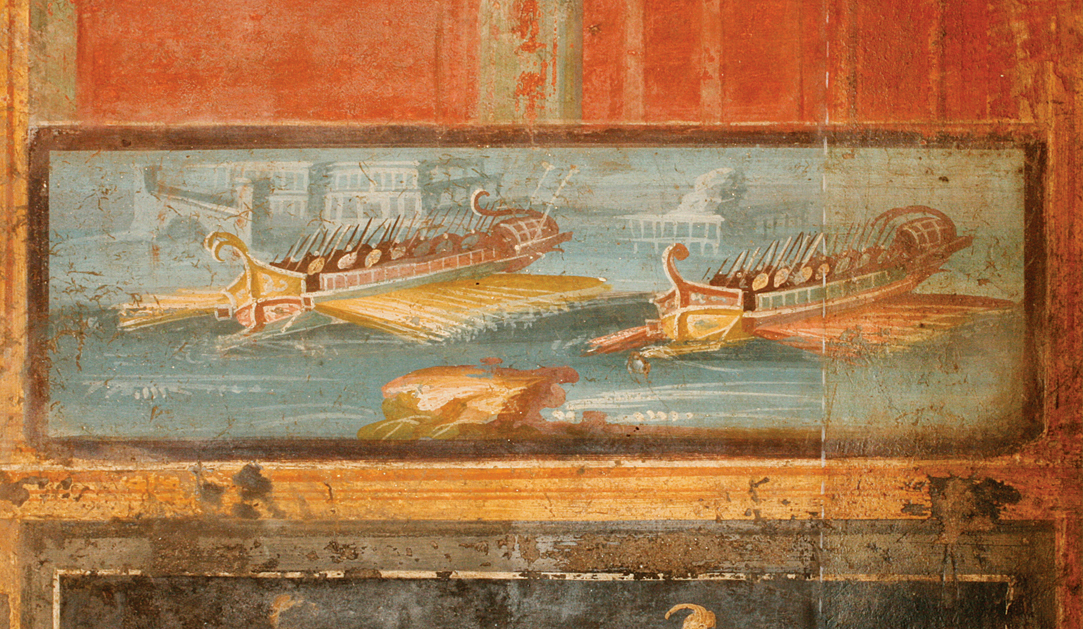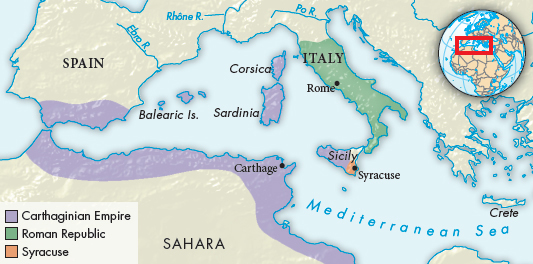A History of World Societies:
Printed Page 151
A History of World Societies Value
Edition: Printed Page 150
Chapter Chronology
Overseas Conquests and the Punic Wars, 264–133 B.C.E.
The Romans did not map out grandiose strategies to conquer the world, as had Alexander the Great. Rather they responded to situations as they arose. This meant that they sought to eliminate any state they saw as a military threat.
Their presence in southern Italy brought the Romans to the island of Sicily, where they confronted another great power in the western Mediterranean, Carthage (CAHR-thij). The city of Carthage had been founded by Phoenicians as a trading colony in the eighth century B.C.E. (see “The Emergence of New States” in Chapter 2). It commanded one of the best harbors on the northern African coast and was supported by a fertile inland. By the fourth century B.C.E. the Carthaginians began to expand their holdings, and they engaged in war with the Etruscans and Greeks. At the end of a long string of wars, the Carthaginians had created and defended a mercantile empire that stretched from western Sicily to beyond Gibraltar.

Two Triremes Race In this fresco painting from the temple of Isis in Pompeii, two triremes — narrow warships powered by several banks of long oars — race in what was most likely a festival celebrating the goddess. Greeks, Carthaginians, and Romans all used triremes, which had bronze front pieces designed to smash into enemy ships. The one hundred to two hundred oarsmen had to row in time to achieve the necessary speed, which took long practice, so this religious celebration also served a military purpose. (© Ministero per i Beni le Attività Culturali — Soprintendenza archeologia de Napoli/Scala/Art Resource, NY)

The Carthaginian Empire and the Roman Republic, 264B.C.E.
The conflicting ambitions of the Romans and Carthaginians led to the first of the three Punic Wars. During the course of the first war, which lasted from 264 B.C.E. to 241 B.C.E., Rome built a navy and defeated Carthage in a series of sea battles. Sicily became Rome’s first province, but despite a peace treaty, the conflict was not over.
Carthaginian armies moved into Spain, where Rome was also claiming territory. The brilliant Carthaginian general Hannibal (ca. 247–183 B.C.E.) marched an army of tens of thousands of troops — and, more famously, several dozen war elephants — from Spain across what is now France and over the Alps into Italy, beginning the Second Punic (PYOO-nik) War (218–201 B.C.E.). Hannibal won three major victories, including a devastating blow at Cannae in southeastern Italy in 216 B.C.E. There he inflicted perhaps fifty thousand casualties on the Romans. He then spread devastation throughout Italy, and a number of cities in central and southern Italy rebelled against Rome because it appeared to them that Hannibal would be victorious. Yet Hannibal was not able to win areas near Rome in central Italy. His allies, who included Philip V, the Antigonid king of Macedonia (see “Hellenistic Society, 323-30 B.C.E.” in Chapter 5), did not supply him with enough food and supplies to sustain his troops, and Rome fought back.
The Roman general Scipio Africanus (ca. 236–ca. 183 B.C.E.) copied Hannibal’s methods of mobile warfare and guerrilla tactics and made more extensive use of cavalry than had earlier Roman commanders. He took Spain from the Carthaginians and then struck directly at Carthage itself, prompting the Carthaginians to recall Hannibal from Italy to defend the homeland. In 202 B.C.E., near the town of Zama, Scipio defeated Hannibal in one of the world’s truly decisive battles. Scipio’s victory meant that the world of the western Mediterranean would henceforth be Roman. Roman language, law, and culture, fertilized by Greek influences, would in time permeate this entire region.
The Second Punic War contained the seeds of still other wars. Unabated fear of Carthage led to the Third Punic War (149–146 B.C.E.), a needless, unjust, and savage conflict that ended when Scipio Aemilianus, a grandson by adoption of Scipio Africanus, destroyed the hated rival and burned Carthage to the ground.
After the Second Punic War, the Romans turned east. The Roman legions were victorious over Macedonian troops, and the Romans made Antigonid Macedonia into a Roman province. Then they moved farther east and defeated the Seleucid monarchy. In 133 B.C.E. the king of Pergamum in Asia Minor willed his kingdom to Rome when he died. The Ptolemies of Egypt retained formal control of their kingdom, but they obeyed Roman wishes in terms of trade policy. Declaring the Mediterranean mare nostrum, “our sea,” the Romans began to create a political and administrative machinery to hold the Mediterranean together under a mutually shared cultural and political system of provinces ruled by governors sent from Rome.
Not all Romans were joyful over Rome’s conquest of the Mediterranean world; some considered that victory a misfortune. The historian Sallust (86–34 B.C.E.), writing from hindsight, complained that the acquisition of an empire was the beginning of Rome’s troubles:
But when through labor and justice our Republic grew powerful . . . then fortune began to be harsh and to throw everything into confusion. The Romans had easily borne labor, danger, and hardship. To them leisure, riches — otherwise desirable — proved to be burdens and torments. So at first money, then desire for power, grew great. These things were a sort of cause of all evils.2

